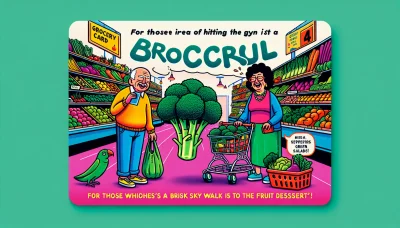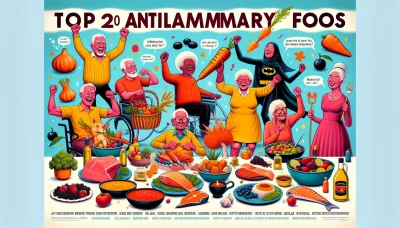High fiber lunch foods Quiz
Test Your Knowledge
Question of
Understanding High Fiber Lunch Foods
Importance of Fiber in Your Diet
Fiber is a nutritional powerhouse, essential for maintaining a healthy digestive system. It helps to keep things moving along the gastrointestinal tract and can prevent common issues such as constipation. Including fiber-rich foods in your diet is an incredible way to support overall gut health.
But that's not all! Fiber plays a critical role in blood sugar regulation by slowing down the absorption of sugar. This can prevent spikes in blood glucose levels, which is particularly beneficial for individuals managing diabetes or watching their glycemic intake.
When it comes to weight management, fiber is your best friend! It provides a feeling of fullness without adding excess calories. This natural appetite suppressant can help you resist the urge to snack between meals and ultimately assist in weight loss or maintenance efforts.
Boosting Digestive Health
Incorporating high-fiber foods into your lunch can transform your digestive wellness. A diet rich in fiber increases stool bulk and accelerates passage through the colon. This not only keeps you regular but also reduces the risk of developing chronic diseases such as colorectal cancer.
The benefits extend beyond digestionhigh-fiber lunches contribute to a flourishing gut microbiome. The fermentation of fiber produces short-chain fatty acids that nourish colon cells and provide numerous health benefits. Embrace those fibrous foods for a happy gut!
Regulating Blood Sugar Levels
Eating high-fiber foods at lunchtime can create a sustained release of energy throughout the afternoon. This steady energy release helps maintain consistent blood sugar levels, keeping those mid-afternoon slumps at bay.
If you're looking for long-term health benefits, look no further than fiber's ability to improve insulin sensitivity over time. Regular consumption of high-fiber meals can be a game-changer in preventing or managing Type 2 diabetes.
Enhancing Satiety and Weight Management
A high-fiber lunch will leave you feeling satisfied longer, reducing the likelihood of reaching for unhealthy snacks later on. By filling up on fiber-rich foods, you're less likely to overeat during subsequent meals, which supports ongoing weight management.
Fiber's role in weight control is supported by its low-calorie profile and its ability to regulate hunger hormones like ghrelin. By understanding how fiber contributes to fullness, you can strategically plan your meals for optimal satiety and calorie control.
Identifying High Fiber Foods
- Whole Grains for Sustained Energy: Swap out white bread for whole-grain options like quinoa, barley, or brown rice. These grains not only provide essential nutrients but also offer dietary fiber that keeps you energized throughout the day.
- Legumes as Protein and Fiber Powerhouses: Beans, lentils, and chickpeas are incredible sources of both protein and fiber. They're versatile ingredients that can be added to salads, soups, or wraps for a nutritious lunch boost.
- Vegetables and Fruits for Nutrient Diversity: Don't forget about the fiber found in fruits and vegetables! Berries, pears, apples with skin on, carrots, broccoli, and leafy greens are all excellent choices that add color, texture, and vital nutrients to your plate.
Whole Grains for Sustained Energy
Ditch refined grains and choose whole grains like oats or spelt for lunchtime meals. Their complex carbohydrates break down slowly, providing a gradual supply of energy that keeps you alert and focused until dinner.
The beauty of whole grains goes beyond just fiber; they contain vitamins and minerals essential for good health. Including a variety of whole grains in your diet ensures a broad spectrum of nutrients while keeping hunger pangs at bay.
Legumes as Protein and Fiber Powerhouses
Incorporate legumes into your lunch routine for an unbeatable combination of protein and fiber. They're incredibly filling and offer a plant-based protein alternative that's kinder to the planet than many animal proteins.
Besides being deliciously versatilethink hummus spread on whole grain bread or black bean souplegumes are affordable pantry staples that make high-fiber eating accessible to everyone.
Vegetables and Fruits for Nutrient Diversity
Veggies aren't just about vitaminsthey're also about fiber! Adding vegetables like Brussels sprouts or kale to your lunch will not only brighten up your meal but also contribute significantly to your daily fiber intake.
Fruits are sweet treats with a bonus: they pack a punch of fiber too! An apple or pear with lunch satisfies sweet cravings while also delivering beneficial fibers that aid digestion and heart health.
Crafting a Balanced High Fiber Meal Plan
Structuring Your Daily Intake
Kicking off your day with a high-fiber breakfast sets the tone for sustained energy and digestion. Opt for whole grains like oatmeal or quinoa, and add a portion of fruit such as berries or an apple to amplify fiber content. Including chia seeds or flaxseeds can also boost your morning fiber intake significantly.
For lunch, aim to incorporate a variety of vegetables alongside lean proteins or legumes. Salads loaded with leafy greens, chickpeas, and an assortment of colorful veggies provide a midday fiber boost. Whole grain wraps or sandwiches with added veggies are convenient options that don't skimp on fiber.
Dinner should be a time to wind down with a satisfying, fiber-rich meal. Think along the lines of grilled vegetables, brown rice, or starchy vegetables like sweet potatoes. Adding a serving of beans or lentils can further enhance the fiber profile of your evening meal.
Breakfast Foundations
Breakfast is the cornerstone of your daily fiber intake. Start with a base of high-fiber cereals or porridge and top it with nuts and fruits for extra roughage. Choosing bran flakes or shredded wheat can make a significant difference in your overall daily intake.
Smoothies are another excellent vehicle for fiber when you're short on time. Blend leafy greens like spinach or kale with high-fiber fruits such as bananas and berries for a quick, nutrient-dense start to your day.
Lunchtime Strategies
Lunch offers an opportunity to pack in fiber through fresh salads or hearty soups. A lentil soup or bean salad packs both protein and fiber, keeping you full until dinner. Remember to include whole grains like brown rice or barley as part of your lunchtime routine.
Dont forget about portable options! Whole-grain breads in sandwiches can up your fiber game, especially when paired with fibrous fillings like avocado, cucumber, and sprouts. They're easy to take on-the-go and can be prepped in advance for convenience.
Dinner Considerations
At dinner, focus on integrating diverse sources of fiber by including both soluble and insoluble types. A stir-fry packed with vegetables such as broccoli, carrots, and bell peppers served over quinoa is an exemplary way to achieve this balance.
- Start with a base of whole grains like quinoa, brown rice, or farro.
- Add a variety of colorful vegetables the more colors, the broader the range of nutrients.
- Include a protein source that's also high in fiber such as beans, chickpeas, or lentils.
- If desired, incorporate lean animal proteins like chicken or fish.
- Finish off with healthy fats from avocados or nuts which can aid nutrient absorption.
- Sprinkle some chia seeds or flaxseeds for an additional fiber boost.
- Stay mindful of portion sizes to maintain balance in your meal plan.
Incorporating Variety and Flavor
Experimenting with International Cuisines
Delving into international cuisines provides an exciting way to enhance your high-fiber diet. Mexican dishes feature beans and avocados while Middle Eastern cuisine offers whole grains like bulgur and legumes such as lentils. These foods are not only flavorful but also naturally rich in fiber.
Using Herbs and Spices for Taste
Herbs and spices are calorie-free ways to add zest to your high-fiber meals without compromising health benefits. Turmeric adds warmth and color; cumin lends earthiness; while fresh herbs like cilantro bring brightness to dishes. They transform simple ingredients into delectable meals that excite the palate while boosting fiber intake.
Trying New Cooking Methods
New cooking methods can make familiar ingredients taste different and exciting while preserving their nutritional value. Roasting vegetables caramelizes their natural sugars, intensifying flavor without adding calories. Steaming preserves the integrity of ingredients' fibers while keeping meals light and nutritious.
High Fiber Recipes for Satisfying Lunches
Easy-to-Prepare High Fiber Dishes
Kickstart your midday meal with an explosion of flavor and fiber! Easy-to-prepare dishes are your best friend when it comes to a satisfying lunch that keeps you full for hours. These recipes are not only bursting with nutritional benefits but also ensure that you have more time to enjoy your meal rather than just preparing it.
Quick Salad Combinations: Dive into a world of crisp greens and vibrant veggies with quick salad combinations. Toss together some kale, chickpeas, cherry tomatoes, and a sprinkle of chia seeds for a fiber-packed feast. Drizzle with your favorite vinaigrette and watch how this simple dish becomes a lunchtime favorite!
Hearty Soup Recipes: Nothing says comfort like a warm bowl of soup. Lentil, barley, and vegetable soups are not just comforting; they're also high in fiber. They can be made in large batches ahead of time, making them perfect for those busy days when you need a quick lunch option.
Simple Whole Grain Wraps and Sandwiches: Transform your lunch into a fiber fiesta with whole grain wraps and sandwiches. Stuff them with hummus, spinach, shredded carrots, and cucumbers for a crunchy and satisfying meal. They're portable, customizable, and absolutely delicious!
Creative Cooking Techniques
To maximize both taste and nutrition in your high-fiber lunches, creative cooking techniques are key! These methods help retain the natural goodness of ingredients while enhancing flavors to delight your taste buds.
Baking with Fiber-Rich Flours: Baking isn't just for sweets; it's a fantastic way to create savory lunch options too. Use fiber-rich flours like almond or coconut flour for baking breads or savory muffins that are not only tasty but also good for your gut health.
Stir-Frying for Nutrient Retention: Keep the crunch in your veggies and the nutrients intact by stir-frying them. This quick-cooking method locks in flavors and textures while adding that perfect charred note to your high-fiber vegetables. Add tofu or tempeh for an extra protein boost!
Slow Cooking for Depth of Flavor: When it comes to layering flavors while keeping things healthy, slow cookers are magic pots! Beans, whole grains, and fibrous vegetables thrown into the slow cooker can turn into rich stews or chilis that offer depth of flavor alongside immense nutritional value.
- Avoid Overcooking: To preserve fibers and nutrients, avoid overcooking your high-fiber ingredients.
- Mind the Dressings: Opt for homemade or low-calorie dressings on salads to keep meals healthy.
- Balanced Spices: Use spices judiciously to enhance natural flavors without overpowering them.
- Variety is Key: Rotate grains and veggies to get a range of fibers and prevent boredom.
- Hydration Matters: Increase water intake as you up your fiber to aid digestion.
- Serving Sizes: Be mindful of portion sizes; high-fiber foods can be more filling than you expect.
- Freshness First: Always choose fresh produce where possible for the best quality fibers.
Managing Special Dietary Needs with High Fiber Foods
Adapting Meals for Food Sensitivities
Tackling food sensitivities can be challenging, but incorporating high fiber foods into your diet doesn't have to be. With a bit of creativity and knowledge, you can enjoy a variety of meals that cater to your dietary restrictions while still providing the benefits of fiber.
Understanding the balance between high fiber intake and managing sensitivities is key. It's about finding those fiber-rich foods that agree with your body, ensuring you can maintain a well-rounded diet without discomfort.
Gluten-Free High Fiber Options
Navigating a gluten-free diet? Fear not! There are ample delicious and nutritious high fiber alternatives available. From quinoa to brown rice and even chia seeds, these substitutes keep your fiber intake robust without a speck of gluten in sight.
Don't forget about fruits and vegetables, nature's gluten-free wonders that are inherently rich in fiber. Berries, pears, and leafy greens are just a few options to naturally boost your diet's fiber content.
Low-FODMAP Fiber Sources
Low-FODMAP diets require careful selection of high fiber foods to avoid gastrointestinal distress. Fortunately, certain grains, seeds, and fruits fit the bill perfectly. Think oats, carrots, and oranges these are your allies in the quest for gut-friendly fiber!
Focusing on tolerable portions is essential when incorporating high-fiber low-FODMAP foods into your diet. Gradual introduction allows your digestive system to adjust without overwhelming it.
Dairy-Free Ways to Boost Fiber
Dairy-free diets don't have to mean compromising on fiber. There's an entire arsenal of plant-based sources at your disposal! Legumes, nuts, and whole grains are powerhouses of dairy-free fiber that can be seamlessly integrated into any meal.
Create exciting dairy-free and fiber-packed dishes by exploring various cuisines that emphasize plant-based ingredients. Middle Eastern hummus or South American quinoa salads are just starters in the vast array of options available.
Catering to Specific Health Conditions
High Fiber Diets for Heart Health
A heart-healthy diet isn't complete without a generous helping of high fiber foods. Soluble fibers found in oats, legumes, and flaxseeds can help reduce cholesterol levels and support overall cardiovascular health.
The power of high fiber diets extends beyond just cholesterol management; they also contribute to reducing blood pressure and inflammation all key factors in maintaining a healthy heart.
Diabetic-Friendly High Fiber Choices
- Balancing Blood Sugar: Incorporate soluble fibers from foods like barley and nuts to help moderate blood sugar spikes after meals.
- Glycemic Control: Choose whole fruits over juices for a slower release of sugars into the bloodstream due to their higher fiber content.
- Portion Awareness: Be mindful of portion sizes; even high-fiber foods can lead to excess calorie intake if not managed properly.
- Diverse Diet: A varied diet rich in different types of fibers ensures a broad spectrum of benefits while keeping mealtime interesting.
- Hydration is Key: As you increase your fiber intake, make sure to drink plenty of water to aid digestion and avoid constipation.
Eating diabetic-friendly doesn't mean sacrificing flavor or variety. With the right selection of beans, lentils, and colorful vegetables, you can enjoy satisfying meals that keep both your taste buds and blood sugar levels happy.
Incorporating low glycemic index foods is crucial for diabetics seeking to add more fiber without causing rapid glucose increases. Foods like sweet potatoes and whole grain breads offer excellent options for steady energy release throughout the day.
Fiber-Rich Foods for Digestive Disorders
If you're dealing with digestive disorders, soluble fibers found in oat bran, psyllium husk, and apples can be soothing for the gut. They help regulate bowel movements without causing irritation an essential factor when managing conditions like IBS or Crohn's disease.
The right kind of dietary fibers not only aids digestion but also acts as prebiotics fueling beneficial gut bacteria which play a vital role in overall digestive health. Integrating these into daily meals could transform your gut health significantly!
Overcoming Common Challenges with High Fiber Diets
Dealing with Digestive Adjustments
Transitioning to a high fiber diet can sometimes lead to digestive discomfort. It's critical to understand that your body needs time to adapt. Gradual increases in dietary fiber allow your gut flora to adjust without causing significant distress.
As you incorporate more fiber-rich foods into your meals, be mindful of how your body responds. If you experience minor digestive changes, consider this a normal part of the adjustment period. Patience and persistence are key as your body acclimates to this healthier eating pattern.
Easing into Increased Fiber Intake
When boosting fiber intake, start slow! Abrupt changes can overwhelm your digestive system. Incrementally add fiber-rich foods to your diet over several weeks, allowing your body ample time to adjust. This approach helps minimize potential discomfort and encourages long-term dietary changes.
Managing Gas and Bloating
A common concern when upping fiber is increased gas and bloating. Combat this by pacing your fiber intake throughout the day and choosing cooked vegetables over raw ones initially. If certain high-fiber foods exacerbate the issue, modify your diet accordingly and consult a healthcare provider if necessary.
Staying Hydrated to Aid Digestion
Hydration is a vital companion to a high-fiber diet! Water helps fiber move smoothly through the digestive system, reducing potential blockages or discomfort. Aim for at least eight glasses of water daily and consider even more if you're active or live in a hot climate.
Ensuring Adequate Nutrient Absorption
A high-fiber diet's benefits can be overshadowed if not balanced correctly with nutrient absorption. Fiber binds with certain nutrients which may lead to reduced absorption rates. Strike a balance by eating a varied diet rich in all essential nutrients.
To maximize the benefits of your high-fiber diet, it's crucial to understand its interaction with other nutrients. For instance, some fibers may impede the absorption of minerals like iron and zinc. Thus, timing is everythingspace out high-fiber meals from those rich in minerals for optimal absorption.
Balancing Fiber with Other Nutrients
Ensure you're not just filling up on fiber at the expense of other vital nutrients such as proteins, fats, and vitamins. A diverse diet that includes a variety of food groups is essential for overall health and well-being while following a high-fiber eating plan.
Timing Fiber Intake Effectively
- Avoid consuming large amounts of fiber with iron or calcium-rich meals to prevent mineral binding.
- Incorporate higher-fiber foods earlier in the day to give your body time to process them.
- If taking medication, consult with your doctor about the best times to consume high-fiber foods as they could affect drug absorption.
- Eat fermented fiber-rich foods like kimchi or sauerkraut which can help improve gut health and nutrient uptake.
- Maintain consistent meal times each day for regular digestive patterns, aiding in better nutrient absorption.
- Select soluble fibers such as oats or apples which tend not to interfere as much with mineral absorption.
- Bear in mind that hydration also plays a role in nutrient absorptiondrink plenty of fluids!
Recognizing Signs of Excessive Fiber
While increasing dietary fiber is generally beneficial, there's such a thing as too much! Excessive fiber intake can lead to uncomfortable symptoms like cramping, diarrhea, or even nutritional deficiencies due to reduced nutrient absorption.
If you notice persistent gastrointestinal issues despite gradual increases in dietary fiber, it might be time to reassess your intake levels. Pay attention to both soluble and insoluble fibersbalancing these two types is essential for maintaining good digestive health without going overboard.
Meal Prepping for a High Fiber Week
Planning and Organizing Your Meals
Building a Weekly Meal Plan
Embarking on a high-fiber diet starts with an exhilarating plan! Sketch out your meals for the week with an array of fiber-rich foods like legumes, whole grains, fruits, and veggies. Balance is key, so pair these with lean proteins and healthy fats to keep your energy soaring.
An organized meal plan acts as your roadmap to success. It ensures you're hitting your fiber targets daily while preventing the last-minute rush to find suitable options. This proactive approach keeps you in control of your dietary goals and taste buds!
Shopping for High Fiber Ingredients
Hit the grocery store with confidence and a laser-focused shopping list! Aim for whole-food ingredients packed with fiberthink beans, oats, berries, and chia seeds. These champions of fiber will be the building blocks of your weekly meals.
Avoid the siren call of processed foods by sticking to the perimeter of the store where fresh produce lives. This strategy not only boosts your fiber intake but also reduces temptation, keeping you steadfast on your high-fiber quest.
Preparing Ingredients in Advance
Prepping ingredients ahead of time is a game-changer! Dedicate a few hours to chopping vegetables, cooking grains, and portioning nuts and seeds. This upfront effort pays dividends throughout the week when quick assembly is all that stands between you and a fiber-packed meal.
Consider roasting a variety of root vegetables or preparing a large batch of quinoa. These versatile staples can be transformed into multiple dishes, making them invaluable allies in your high-fiber arsenal.
Tips for Storing and Reheating Meals
Best Practices for Food Safety
- *
- Cool it down: Allow cooked food to cool before refrigeration to prevent bacterial growth. *
- Airtight containers: Store meals in sealed containers to maintain freshness and avoid contamination. *
- Label it: Date your containers to keep track of when they were stored and prioritize eating older meals first. *
- Avoid cross-contamination: Keep raw and cooked foods separate during storage to prevent foodborne illnesses. *
- Mind the temperature: Ensure your fridge is at the right temperature (below 40F or 4C) to slow bacterial growth. *
- Freeze for longevity: Freeze portions that won't be eaten within a few days to preserve their quality over time.
Maintaining Nutritional Quality When Reheating
To retain the magnificent benefits of your high-fiber foods, reheat gently. Microwaving slowly at a lower power setting or warming through in a pan over low heat can help preserve nutrients that are sensitive to high temperatures.
Bear in mind that some high-fiber foods like certain vegetables may become even more nutritious after reheating. The key is moderationoverheating can lead to nutrient loss, so stay vigilant!
Portioning Meals for Convenience
The magic of meal prepping shines when it comes to portion control. Divide meals into individual servings from the get-go. This brilliant move simplifies decision-making at meal times and aids in managing portion sizes effortlessly.
Your future self will thank you as you grab a ready-to-go meal container from the fridge or freezer. It's convenience wrapped up in healthy habits, making adherence to your high-fiber diet both easy and enjoyable!
Tracking Your Progress on a High Fiber Diet
Setting Realistic Goals and Expectations
Embarking on a high fiber diet is an exhilarating journey towards better health, but it's crucial to set realistic goals. Start by aiming for gradual increases in fiber intake to allow your body to adjust. This approach reduces the risk of digestive discomfort and builds sustainable eating habits. Remember, quick fixes are not the goal; lasting health improvements are.
Your body's response to increased fiber is a telltale sign of how well you're adapting. Pay close attention to changes in digestion, energy levels, and overall well-being. These indicators will help you fine-tune your fiber intake. If you experience bloating or discomfort, it's a signal to reassess your approach.
Adjusting your fiber goals over time is not just smart; it's essential! As your body acclimates to higher fiber levels, you can continue to raise the bar. This dynamic strategy ensures that you're always moving forward without pushing your body too hard, too fast.
Establishing Daily Fiber Targets
The cornerstone of a successful high fiber diet is setting daily targets. Aiming for the recommended 25-30 grams per day sets a clear benchmark for success. But don't let numbers intimidate you! Focus on incorporating a variety of fiber-rich foods like fruits, vegetables, legumes, and whole grains into every meal.
Maintaining consistency with your daily targets is key to reaping the full benefits of dietary fiber. Keep in mind that balance is important distributing fiber intake throughout the day helps prevent digestive distress and keeps energy levels steady.
Monitoring Your Body's Response
A high fiber diet can transform your health, but monitoring your body's response is critical. Look out for signs of improved digestion such as regular bowel movements and less bloating. Positive changes in these areas are clear indicators that you're on the right track.
However, be vigilant for any adverse reactions as well. If you notice increased discomfort or other digestive issues, it may be necessary to adjust your fiber intake or consult with a healthcare professional. Listen to your body; it knows best!
Adjusting Goals as Needed
As you progress on your high fiber journey, stay flexible and ready to adjust your goals as needed. Your dietary needs may evolve due to changes in lifestyle, health status, or personal preferences. Regularly assess and modify your targets to ensure they align with your current situation.
If you hit roadblocks or plateaus, don't get discouraged! These challenges are merely opportunities to learn more about your body and refine your diet accordingly.
Utilizing Tools and Resources
To stay on top of your high fiber game, leverage tools like food diaries or apps designed for dietary tracking. Documenting every bite helps identify patterns and areas for improvement while keeping you accountable.
- Food Diary Tips:
- Note everything: Record all meals, snacks, and beverages consumed.
- Include details: Specify portion sizes and preparation methods.
- Track symptoms: Jot down any physical responses post-meal.
- Analyze regularly: Review entries weekly to gauge progress.
- Stay honest: Even small bites count; honesty ensures accuracy!
Using Apps to Track Intake and Symptoms
In today's digital age, harnessing the power of apps can make tracking effortless and precise. Many apps provide extensive databases of foods with their corresponding fiber contentturning guesswork into knowledge at your fingertips!
Beyond mere numbers, some apps enable symptom logginga vital feature that connects dietary habits with physical reactions. This holistic view empowers you with insights that guide future dietary decisions.
Seeking Support from Nutrition Communities
You're not alone on this high-fiber odyssey! Join online communities or local groups where fellow fiber enthusiasts share tips, recipes, and support. These networks can be invaluable sources of motivation and knowledge exchange.
The collective wisdom found in these communities often leads to creative solutions for common challenges faced when increasing dietary fiber. Engage activelyyou'll find camaraderie strengthens commitment!












